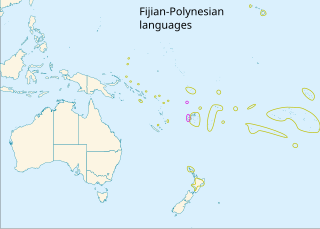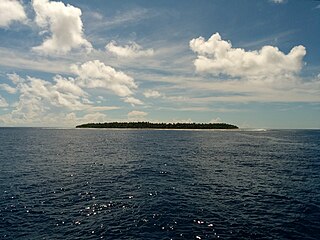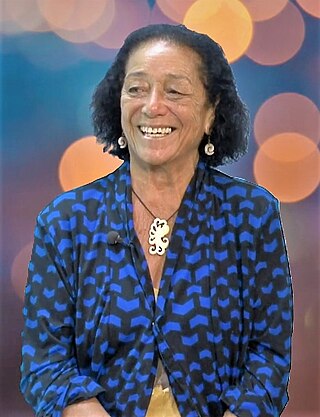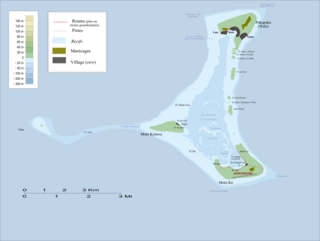
Yato is one of three villages on the island of Wale in the Pukapuka atoll of the Cook Islands. Yato is the westernmost village and regulates the island of Motu Kotawa [1] and the sand cay of Toka. [2]
Niua School is located in the village.

Yato is one of three villages on the island of Wale in the Pukapuka atoll of the Cook Islands. Yato is the westernmost village and regulates the island of Motu Kotawa [1] and the sand cay of Toka. [2]
Niua School is located in the village.

The Cook Islands can be divided into two groups: the Southern Cook Islands and the Northern Cook Islands. The country is located in Oceania, in the South Pacific Ocean, about halfway between Hawaii and New Zealand.

The Polynesian languages form a genealogical group of languages, itself part of the Oceanic branch of the Austronesian family.

Pukapuka, formerly Danger Island, is an inhabited coral atoll in the northern group of the Cook Islands in the Pacific Ocean. It is one of the most remote islands of the Cook Islands, situated about 1,140 kilometres northwest of Rarotonga. On this small island, an ancient culture and distinct language have been maintained over many centuries. The traditional name for the atoll is Te Ulu-o-Te-Watu, and the northern islet where the people normally reside is affectionately known as Wale ('Home').
Pukapukan is a Polynesian language that developed in isolation on the island of Pukapuka in the northern group of the Cook Islands. As a "Samoic Outlier" language with strong links to western Polynesia, Pukapukan is not closely related to any other languages of the Cook Islands, but does manifest substantial borrowing from some East Polynesian source in antiquity.

Rakahanga is part of the Cook Islands, situated in the central-southern Pacific Ocean. The unspoilt atoll is 1,248 kilometres from the Cook Islands' capital, Rarotonga, and lies 1,111 kilometres south of the equator. Its nearest neighbour is Manihiki which is just 44 kilometres away. Rakahanga's area is 4 square kilometres (1.5 sq mi). Its highest point is approximately 5 metres above sea level. The population was 83 in the 2016 Census of Population & Dwellings, with a density ratio of 32 people per square kilometer. Since 2014 Rakahanga's electicity has been 100% solar generated. The Rakahanga-Manihiki language differs from Cook Islands Maori.

Nassau is an island in the northern group of the Cook Islands. It is approximately 1,246 kilometres (774 mi) north of the capital island of Rarotonga and 88 kilometres (55 mi) from Pukapuka coral atoll. Lacking an airstrip, it is accessible only by boat. It is named after a 19th-century whaling ship. Its indigenous name, Te Nuku-o-Ngalewu, means "Land of Ngalewu" after the Pukapukan who was put in charge of it.

Manihiki is an atoll in the northern group of the Cook Islands known informally as the "Island of Pearls". It is located in the Northern Cook Island chain, approximately 1,299 kilometres (807 mi) north of the capital island of Rarotonga, making it one of the most remote inhabitations in the Pacific Ocean. Its name has two possible meanings: It is believed that the original name of the island was Manuhiki, inspired by the aboriginal discoverers, Manu coming from the word Rua Manu and Hiki meaning ashore, so the literal translation would be canoe carried ashore. The second interpretation is that the original discoverers were from Manihi, an island in Tuamotus, so the name of the island would mean Little Manihi.
Robert Dean Frisbie was an American writer of travel literature about Polynesia.
Tema Reef, also called Tima Reef, is a submerged coral reef in the northern island group of the Cook Islands, 23 kilometres southeast of Pukapuka coral atoll.

The Northern Cook Islands is one of the two chains of atolls which make up the Cook Islands. Lying in a horizontal band between 9° and 13°30' south of the Equator, the chain consists of the atolls of Manihiki, Nassau, Penrhyn, Pukapuka, Rakahanga and Suwarrow, along with the submerged Tema Reef.
Akava'ine is a Cook Islands Māori word which has come, since the 2000s, to refer to transgender people of Māori descent from the Cook Islands.

Florence Ngatokura "Johnny" Frisbie, also known as Johnny Frisbie Hebenstreit, is a Cook Islands author. Her autobiographical children's novel, Miss Ulysses of Puka-Puka (1948), was the first published literary work by a Pacific Islander woman author.

Motu Kotawa is one of three islands in the Pukapuka atoll of the Cook Islands. It forms the western apex of Pukapuka's triangular atoll, and is the smallest of the three islands. The island is low-lying, with a maximum elevation of 3 meters above sea level. The island is uninhabited and used as a food source. It is home to numerous Frigatebirds, as well as plantations of taro, papaya, breadfruit, coconuts and bananas, and is regulated by the village of Yato. A reef extends from the west of the island, connecting it to the islet of Toka.

Motu Kō is one of three islands in the Pukapuka atoll of the Cook Islands. It forms the southern apex of Pukapuka's triangular atoll, 10km south of Wale, and is the largest of the three islands. The island is low-lying, with a maximum elevation of 5 meters above sea level and most of it only one or two meters. Motu Kō is uninhabited and used as a food source, and is regulated by the village of Ngake.

Wale ("house") is one of three islands in the Pukapuka atoll of the Cook Islands. It forms the northern apex of Pukapuka's triangular atoll, and is the only permanently inhabited island. The island is low-lying, with a maximum elevation of 4 meters above sea level. The three villages of Yato, Loto, and Ngake are located on the island, and regulate the other two islands as food sources.

Toka is a sand cay in the Pukapuka atoll of the Cook Islands. The cay is to the west of the atoll, separated from the island of Motu Kotawa by a reef. It is regulated by the village of Yato, and is extremely dangerous to land on.

Ngake is one of three villages on the island of Wale in the Pukapuka atoll of the Cook Islands. It is the easternmost village and regulates the island of Motu Kō.

Loto is one of three villages on the island of Wale in the Pukapuka atoll of the Cook Islands. It is the central village and regulates Motu Uta, the major food-production area on Wale.

The Central Polynesian tropical moist forests is a tropical and subtropical moist broadleaf forests ecoregion in Polynesia. It includes the northern group of the Cook Islands, the Line Islands in Kiribati, and Johnston Atoll, Jarvis Island, Palmyra Atoll, and Kingman Reef which are possessions of the United States.
10°51′12.56″S165°50′49.96″W / 10.8534889°S 165.8472111°W